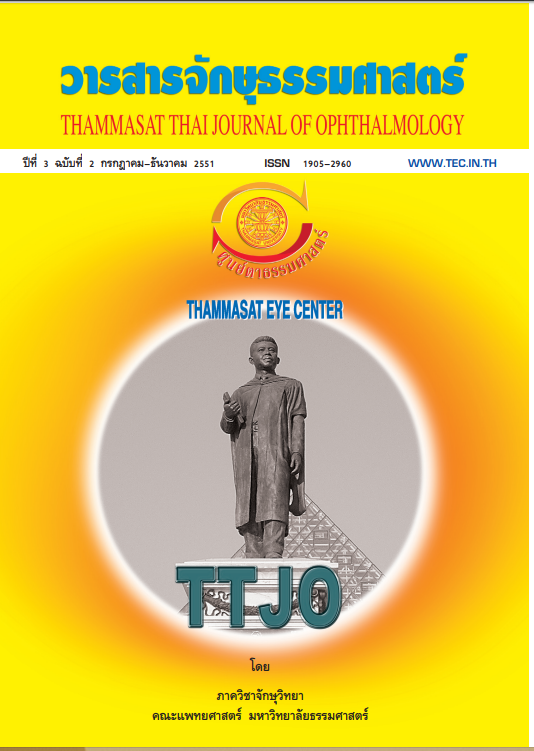A 7-Year-Old Boy with Hand-Schüller-Christian Disease
Main Article Content
Abstract
Purpose : To present a case of classical triads in a patient with Hand-SchÜller-Christian disease.
Methods : Case report.
Results : A 7-year-old boy presented with bilaterally slow progressive exophthalmos and subcutaneous nodules in the scalp and chin for 2 years. Radiologically, the skeletal survey revealed irregular well defined osteolytic area with thin, sclerotic borders limited to skull vault. On enquiry, he also gave symptoms of diabetes insipidus. Tissue biopsy and immunostainings have had Langerhans cell histiocytosis and positives for CD1a, S100 and CD68. The patient was diagnosed closely to Hand-SchÜller-Christian disease. Management of Hand-SchÜller-Christian disease includes open biopsy for diagnosis, surgical curettage, localized radiotherapy, chemotherapy in acute and maintenance phase, supportive therapy and surgery in specific indications. Long-term monitor should be considered and consulted for associated abnormalities.
Conclusions : Hand-SchÜller-Christian disease is a rare entity comprising of exophthalmos, diabetes insipidus and geographical map skull. Though the triads remain important for diagnosis, number of other features have also been described. Long term surveillance should be emphasize to prevent loss of function and risk monitoring.
Key words : Hand-SchÜller-Christian disease, Histiocytosis, Langerhans cell histiocytosis, exophthalmos, diabetes insipidus
เด็กชายไทยอายุ 7 ปี ที่มาด้วยกลุ่มอาการโรค Hand-Schüller-Christian
วัตถุประสงค์: เพื่อนำเสนอผู้ป่วยกลุ่มอาการโรค Hand-Schüller-Christian ที่มาด้วยลักษณะอาการสำคัญ 3 อย่าง
วิธีการศึกษา: รายงานผู้ป่วย (case report)
ผลการศึกษา: ผู้ป่วยเด็กชาย อายุ 7 ปี มีอาการตาโปน (exophthalmos) ค่อย ๆ โปนมากชึ้นเป็นเวลา 2 ปี ร่วมกับมีก้อนเรื้อรังที่บริเวณศรีษะและคาง โดยตรวจภาพถ่ายรังสีพบลักษณะกระดูกแหว่งที่ขอบเรียบ (punched-out) และพบอาการของเบาจืด (diabetes insipidus) ประกอบกับผลการตรวจชิ้นเนื้อ รวมทั้งการย้อมพิเศษทางอิมมูโน (immuno-staing) ให้ผลเป็น Langerhans cell histiocytosis และให้ผลบวกต่อ CD1a, S100 และ CD68 จากการย้อมพิเศษ ดังนั้นจึงให้ืการวินิจฉัยเป็น กลุ่มอาการโรค Hand-Schüller-Christian ซึ่งแนวทางในการรักษาในปัจจุบัน อาจแค่ผ่าตัดเฉพาะที่ (surgical curettage), การฉายแสงเฉพาะที่ (localized radiotherapy), หรือการใช้ยาเคมีบำบัด (surgical curettage), การฉายแสงเฉพาะที่ (localized radiotherapy), หรือการใช้ยาเคมีบำบัด (chemotherapy) นั้นขึ้นกับว่าผู้ป่วยมีรอยโรคที่ใด และมีปัจจัยเสี่ยงมากน้อยแค่ไหน โดยในผู้ป่วยรายนี้ได้รับการรักษาโดยวิธียาเคมีบำบัด และต้องคอยเฝ้าสังเกตภาวะแทรกซ้อนที่อาจะเกิดตามมา รวมทั้งการให้คำปรึกษาแก่ครอบครัวประกอบกับควรปรึกษาเพทย์เฉพาะทางระบบอื่น ๆ ร่วมด้วย เพื่อการรักษาที่เหมาะสมกับผู้ป่วย
สรุป: กลุ่มอาการโรค Hand-Schüller-Christian เป็นกลุ่มอาการที่พบได้ค่อนข้างน้อย มีอาการตาโปน ภาวะเบาจืด ร่วมกับตรวจพบรอยแหว่งของกระดูกกะโหลก ซึ่งมีแนวทางในการรักษาหลายวิธีร่วมกัน เพื่อให้ผลของการรักษาผู้ป่วยดียิ่งขึ้น รวมทั้งจำเป็นต้องติดตามผลการรักษาต่อเนื่องแก่ผู้ป่วย


